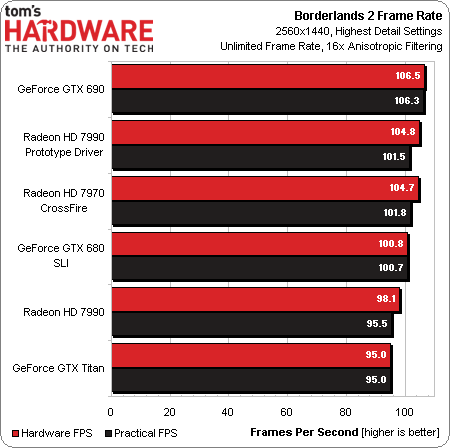AMD Radeon HD 7990: Eight Games And A Beastly Card For $1,000
We've been waiting for this since 2011. AMD is ready to unveil its Radeon HD 7990, featuring a pair of Tahiti graphics processors. Can the dual-slot board capture our hearts with great compute and 3D performance, or does Nvidia walk away with this round?
Results: Borderlands 2
In the interest of brevity, we’ll keep the commentary short on this one. Even at this title’s most demanding settings, 2560x1440 simply isn’t a high-enough resolution to really tax our swath of ~$1,000 graphics configurations.
A higher-end platform would have been nice. So, why didn’t we use the Sandy Bridge-E-based setup we’ve employed in the past? There remains an issue with PCI Express 3.0 compatibility and today’s multi-card arrays, which Nvidia and AMD address differently. In order to avoid introducing additional variables, we chose to stick with Z77 Express and a PCIe 3.0-capable CPU to side-step communications bottlenecks.
The field is clumped together through our benchmark run, giving us little to comment on.
Although Nvidia does a better job of rendering frames consistently, charting out frame time latency shows that AMD is almost every bit as smooth in Borderlands 2. Incidentally, we know that this is one of the titles AMD’s driver team already optimized for, helping explain why this title shines as the Radeons struggle in other games.
Get Tom's Hardware's best news and in-depth reviews, straight to your inbox.
Current page: Results: Borderlands 2
Prev Page Results: BioShock Infinite Next Page Results: Crysis 3-
blackmagnum If I had 1,000 dollars... I would buy a Titan. Its power efficiency, drivers and uber-chip goodness is unmatched.Reply -
timw03878 Here's an idea. Take away the 8 games at 40 bucks a piece and deduct that from the insane 1000 price tag.Reply -
donquad2001 this test was 99% useless to the average gamer,Test the card at 1900x1080 like most of us use to get a real ideal of what its like,only your unigine benchmarks helped the average gamer,who cares what any card can do at a resolution we cant use anyway?Reply -
cangelini whysoPower usage?Thats some nice gains from the prototype driver.Power is the one thing I didn't have time for. We already know the 7990 is a 375 W card, while GTX 690 is a 300 W card, though. We also know AMD has Zero Core, which is going to shave off power at idle with one GPU shut off. I'm not expecting any surprises on power that those specs and technologies don't already insinuate.Reply -
cangelini donquad2001this test was 99% useless to the average gamer,Test the card at 1900x1080 like most of us use to get a real ideal of what its like,only your unigine benchmarks helped the average gamer,who cares what any card can do at a resolution we cant use anyway?If you're looking to game at 1920x1080, I can save you a ton of money by recommending something less than half as expensive. This card is for folks playing at 2560 *at least.* Next time, I'm looking to get FCAT running on a 7680x1440 array ;)Reply -
hero1 Nice article. I was hopping that they would have addressed the whining but they haven't and that's a shame. Performance wise it can be matched by GTX 680 SLI and GTX 690 without the huge time variance and runt frames. Let's hope they fix their whining issue and FPS without forcing users to turn on V-sync. For now I know where my money is going consider that I have dealt with AMD before:XFX and Sapphire and didn't like the results (whining, artifacts, XF stops working etc). Sorry but I gave the red team a try and I will stick with Nvidia until AMD can prove that they have fixed their issues.Reply



